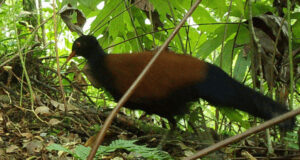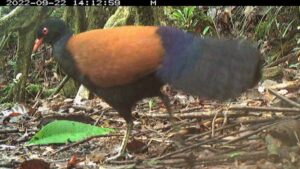In the woods of Papua New Guinea, a bird that had been assumed to be extinct for 140 years was rediscovered.
According to a press statement from the NGO Re:Wild, which assisted in funding the search, the black-naped pheasant pigeon was recorded by biologists for the first and final time in 1882. An expedition team had to work extremely hard for a month on Fergusson, a rough island in the D’Entrecasteaux Archipelago off eastern Papua New Guinea, to rediscover the bird. The team was made up of native employees from the Papua New Guinea National Museum as well as foreign researchers from the American Bird Conservancy and Cornell Lab of Ornithology.
Because Fergusson Island is covered with rocky, steep terrain, the scientific mission will be particularly difficult. According to the news release, many locals told the team they hadn’t seen the black-naped pheasant pigeon in decades. However, a camera trap managed to acquire images of the incredibly rare bird just two days before the researchers were supposed to depart the island. According to the press release from John C. Mittermeier, director of the missing birds’ program at American Bird Conservancy and expedition co-leader, “viewing those initial images of the pheasant-pigeon felt like finding a unicorn after a month of seeking.” As a conservationist and birdwatcher, “it is the kind of moment you dream of for the rest of your life.”

According to the press release, the black-naped pheasant pigeon is a sizable, ground-dwelling pigeon with a broad tail. The population of the species is thought to be small and declining, and scientists still know little about it. For the scientists to find the elusive bird, local knowledge was essential. According to a press statement from conservation biologist and expedition co-leader Jason Gregg, “We didn’t start encountering hunters who had seen and heard the pheasant-pigeon until we reached settlements on the western slope of Mt. Kilkerran.” “We felt like we were moving closer to the core habitat of the black-naped pheasant-pigeon and we were more confident about the local name of the species, which is “Auwo.”
On the slopes of Mt. Kilkerran, the island’s tallest mountain, they set up a total of 12 camera traps. Eight other cameras were also set up in areas where local hunters had previously reported spotting the bird. The last piece of the puzzle that allowed researchers to find the pheasant-pigeon was provided by a hunter by the name of Augustin Gregory, who was based in the mountain village of Duda Ununa. According to the news release, Gregory told the researchers that he had spotted the black-naped pheasant-pigeon in a region with “high peaks and valleys.” Additionally, he had heard the bird’s unique sounds. According to the press release, the expedition team set up a camera on a 3,200-foot-high ridge above Duda Ununa close to the Kwama River. Finally, as their journey concluded, they managed to get some footage of the bird moving across the woodland floor.

Both the scientists and the locals were taken aback by the discovery. Serena Ketaloya, a conservationist from Milne Bay, Papua New Guinea, was quoted in the news release as saying, “The communities were quite excited when they saw the survey results because many people hadn’t seen or heard of the bird until we began our study and acquired the camera trap photographs.” They are eager to collaborate with us to attempt to safeguard the pheasant-pigeon currently. The number of black-naped pheasant pigeons still in existence is unknown, and due to the rough terrain, it will be challenging to count them. The bird was not observed during a two-week survey in 2019, but it did turn up some hunter reports that helped pinpoint the regions for the 2022 expedition.
Moreover, the discovery might give people hope that other bird species that were previously believed to be extinct still exist. The manager of Re:Wild Search for Lost Species, Christina Biggs, remarked in a press release that the recovery “is an incredible beacon of hope for other birds who have been lost for a half-century or more.” Even though very few people could recall seeing the pheasant-pigeon in recent years, the team’s resolve remained unwavering despite the extremely challenging terrain they searched in.
- Misleading Video Alters Prime Minister Shehbaz’s Speech Targeting Political Rival, Not His Party - 21/04/2024
- ATC Grants Three-Day Remand for Suspects in Ichhra Bazaar Harassment Case - 19/03/2024
- Pakistan, India, and Bangladesh Lead World in Severe Smog Crisis, Exceeding WHO Guidelines - 19/03/2024


